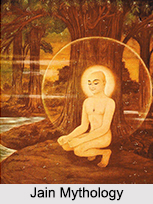 Jain Mythology traces the origin of the Puranas to Lord Mahavira himself and provides a succession of teachers through whom they were handed down by oral tradition from Guru to shishya. It has all the appearance of a purely constructed system. The Gods are classified and subdivided into orders, genera, and species; all are mortal, have their ages fixed, as well as their abodes.
Jain Mythology traces the origin of the Puranas to Lord Mahavira himself and provides a succession of teachers through whom they were handed down by oral tradition from Guru to shishya. It has all the appearance of a purely constructed system. The Gods are classified and subdivided into orders, genera, and species; all are mortal, have their ages fixed, as well as their abodes.
Content of Jain Mythology
The subject matter of Jain Mythology centers around 63 Shalakapurusas (eminent people). They are known as "Pravarapurusas", "Uttamapurusas" and "Mahapurusas". Besides these Shalakapurusas, Jain Mythology deals with, accounts of the kings, Cycle of Time, Structure of the Universe, Metaphysics and Ethical Codes of Conduct of the Four-Fold Community and Philosophy, especially Ahimsa.
Shalakapurusas of Jain Mythology
The 63 Shalakapurusas are classified into 5 groups which are as follows:
12 Chakravartis: The word "Chakravarti" means one who rules over the 6 Khandas of Bharatvarsa. As a reward of the good karmas done in the past, they are born as Chakravartis in the dynasty of Ikshwaku. They are the mighty heroes who rule for a very long time over the country, enjoying pleasures in the company of women and the glory due to an Emperor. Their birth is announced by 14 hazy dreams, which their mothers visualize. They possess 14 Ratnas and 9 Nidhis. The names of the Chakravartis are:
•Bharat
•Shantinatha
•Padmanabha
•Sagar
•Kunthunath
•Harisena
•Maghavan
•Aranath
•Jayasena
•Sanatkumar
•Subhauma
•Brahmadatta
24 Tirthankaras: The word "Tirthankara" means a Spiritual Guide, one who shows the way to cross ocean of worldly existence. Their mother visualizes 14 bright dreams before their birth. They have a pair of a Yaksha and Yakshi as attendant God and Goddess. The information of their height, age, colour, Nakshatra of their birth and the number of their Gandharas, Sadhu, Sadhvi, Sravaka and Sravika are mentioned in various Puranas. Each Tirthankara is also assigned a Lanchana or symbol. The names of the Tirthankaras are:
•Adinath
•Ajitanath
•Sambhavanath
•Abhinandan Swami
•Sumatinath
•Padmaprabhu
•Suparsvanath
•Chandraprabhu
•Suvidhinath
•Sheetalnath
•Sreyamsanath
•Vasupujya Swami
•Vimalanath
•Anantnath
•Dharmanath
•Shantinath
•Kunthunath
•Aranath
•Mallinath
•Munisuvrata Swami
•Naminath
•Neminath
•Parsvanath
•Mahavir Swami
9 Baladevas: Baladevas are very pious and gentle hearted heroes. Their birth is indicated by 4 dreams which their mother visualizes. Their complexion is white and they wear blue garments. They possess 4 Ayudhas – Dhanus (Bow), Gada (Mace), Musala (Pestle) and Hala (Plough). They are also known as Haladhara, Balarama or Balabhadra. The names of 9 Baladevas are as follows:
•Vijay
•Achala
•Dharmaprabha
•Suprabha
•Sudarshan
•Ananda
•Nandana
•Rama
•Balaram
9 Vasudevas: They are also called as Vishnu or Narayana. They have a symbol of Srivatsa on their chest and possess a white parasol and chowries, and his banner portrays an eagle. They are hot-tempered by nature. Their complexion is dark and wears yellow garments. Their birth is indicated by 7 dreams according to Swetambara tradition and 5 according to Digambara. They possess 7 Ayudhas – Pancajanya Sankha (Conch), Sudarshana Chakra (Disc), Kaumodaki Gada (Mace), Saranga Dhanus (Bow), Nandaka Khadga (Sword), Vanamala (Garland) and Kaustubha Ratna (Jewel). The names of 9 Vasudevas are as follows:
•Tripustha
•Dwiprushta
•Swayambhu
•Purushottam
•Purushasimha
•Pundarik
•Datta
•Lakshmana
•Krishna
9 Prati-Vasudevas: They are powerful heroes also called "Ardha-Chakravarti", as they rule 3 continents of the Earth. Their birth is indicated by 1-4 dreams, seen by their mother. The names of Prati-Vasudevas are as follows:
•Ashvagreev
•Tarvaka
•Merak
•Madhukaitabha
•Nishumbha
•Bali
•Prahalad
•Ravana
•Jarasangha




















